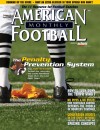Article CategoriesAFM Magazine
|
How to slow down the “Tempo”Wing-Tby: Jake MessinaDefensive Coordinator, Merced High School (CA) © More from this issue During my first year as a Defensive Coordinator, in 2006, we were very fortunate to have an excellent team at Merced High School. Making it to the sectional final and nearly pulling off a last-minute win was an exciting way to begin my career as DC. However, that year was tempered with several doses of humility, mainly at the hands of the wing-t offense (specifically the tempo wing-t). In our second game of the year vs. Madera H.S., coached by wing-t guru Randy Blankenship, and later in the sectional final vs. Vacaville H.S., problems arose that forced us as a staff to take a second look at what we were doing and how we could more effectively defend this multiple-formation offense that snapped the ball within four seconds of the huddle break.
|
|
|||||||
| HOME |
MAGAZINE |
SUBSCRIBE | ONLINE COLUMNISTS | COACHING VIDEOS |
Copyright 2025, AmericanFootballMonthly.com
All Rights Reserved





